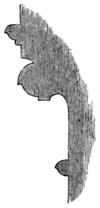The walls are built of flint, with stone quoins, and plastered inside. Externally the flint work is laid in regular courses, and the flints split and squared. The skill and management of the old builders, and the ease with which they made the most rugged materials bend to their purpose, was never better displayed than in the construction of these walls; the thin, narrow joints, sharp surface, and beautiful appearance of the flint work, far surpasses the best attempts of modern days, and proves, whatever else the Church might have been, that it was at least the school of sound architects and good workmen. The aisles are separated from the nave by a stone arcade of five compartments, the arch nearest the chancel of each arcade being narrower and more acutely pointed than the others. The moldings of both pillars and arches are very well worked and in tolerable preservation, and belong, in common with nearly every other part of the church, to the style of architecture prevailing in the early part of the fourteenth century, now better known as the "Decorated."
The west window is by far the finest part of the whole edifice, and even now, worn and dila-




